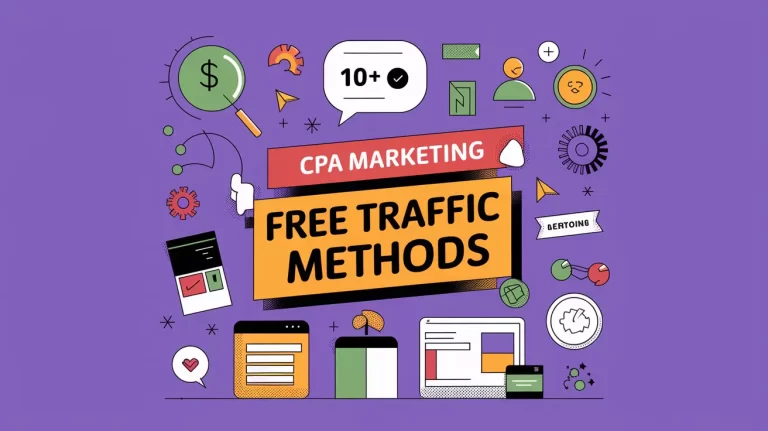In this case study, we will delve into the strategies that contribute to successful CPA marketing campaigns. By understanding the secrets behind these campaigns, you can drive conversions, optimize your marketing efforts, and achieve maximum CPA performance. This comprehensive analysis will provide real-world insights that can be applied to your own campaigns in order to improve your CPA conversion rate.
Table of Contents
What is a CPA Campaign?
Before we dive into the secrets of successful CPA campaigns, let's start by understanding the basics. A CPA campaign, short for Cost Per Acquisition, is a marketing model where advertisers only pay when a specific action is taken by the target audience. This action can range from making a purchase to filling out a form, and it serves as the basis for determining the cost.
A CPA campaign offers several benefits for advertisers. Firstly, it allows for a more targeted approach, ensuring that the ad spend is focused on actual conversions rather than simply impressions. This increases the chances of reaching a high-quality audience that is more likely to convert. Additionally, CPA campaigns provide advertisers with measurable results, enabling them to track their return on investment (ROI), optimize their strategies, and make data-driven decisions.
“A CPA campaign is an effective marketing model where advertisers only pay when a specific action is taken by the target audience.”
Implementing successful CPA campaigns requires careful planning, strategic execution, and continuous optimization. In the next sections, we will explore the various strategies and tactics that can help maximize CPA performance and drive conversions. But first, let's delve into the key factors that contribute to successful CPA campaigns.
Key Factors for Successful CPA Campaigns
- Clear campaign goals and objectives
- Targeting the right audience
- Compelling ad copy and creative
- Optimized landing pages
- Data tracking and analytics
- A/B testing and conversion rate optimization (CRO)
- Effective scaling and budget management
- Adapting to market trends and changes
By understanding and implementing these factors, marketers can significantly improve their CPA conversion rate and achieve campaign success. In the following sections, we will provide detailed insights and strategies for each of these key factors, helping you unlock the full potential of your CPA campaigns.
Setting Goals for Your CPA Campaign
In order to achieve success with your CPA campaign, it's crucial to set clear and measurable goals. By establishing goals upfront, you can strategically plan and execute your campaign for maximum effectiveness.
When setting goals for your CPA campaign, consider the specific objectives you want to achieve. Do you want to increase sales, drive website traffic, generate leads, or perhaps a combination of these goals? Understanding your desired outcomes will help you shape your campaign strategies.
To set effective goals for your CPA campaign, follow these steps:
- Identify your target audience: Understand who your ideal audience is and what motivates them. This will allow you to tailor your campaign to their needs and preferences.
- Define specific metrics: Determine the key performance indicators (KPIs) that align with your overall goals. These can include conversion rate, cost per acquisition, click-through rate, or any other relevant metrics.
- Set achievable targets: Ensure that your goals are realistic and attainable within your budget and resources. Consider past performance data, industry benchmarks, and market trends to set benchmarks.
- Create a timeline: Establish a timeline for your campaign to track progress and make adjustments when needed. Break down your goals into smaller milestones to stay on track.
By following these steps, you can set clear and measurable goals for your CPA campaign, providing a roadmap for success. Aligning your goals with your target audience and selecting the right metrics will help you evaluate the effectiveness of your campaign and make data-driven decisions for optimization.
Example Goal Setting Chart:
| Goal | Target Metric | Target Value | Timeline |
|---|---|---|---|
| Increase sales | Conversion rate | 10% | 3 months |
| Drive website traffic | Click-through rate | 3% | 1 month |
| Generate leads | Cost per acquisition | $5 | 6 months |
Targeting the Right Audience
Effective CPA marketing campaigns rely on targeting the right audience. By understanding the characteristics and preferences of your target audience, you can tailor your message and offers to resonate with them, increasing the chances of conversion. In this section, we will explore various targeting strategies that can help you reach your ideal audience and optimize your CPA campaign for success.
Demographic Targeting
Demographic targeting involves segmenting your audience based on factors such as age, gender, location, and income level. This allows you to deliver highly targeted advertisements that are more likely to appeal to specific demographic groups. By understanding the demographics of your target audience, you can create personalized campaigns that address their unique needs, interests, and pain points. For example, if you're selling beauty products targeting young women, you can create engaging ads featuring relevant imagery and messaging that resonates with this specific demographic.
Behavioral Targeting
Behavioral targeting focuses on understanding the online behavior and browsing habits of your target audience. By analyzing data such as search history, website visits, and past purchase behavior, you can deliver tailored advertisements to individuals who are more likely to be interested in your products or services. Behavioral targeting allows you to reach potential customers at the right time, in the right place, and with the right message. For instance, if you run an online clothing store, you can target users who have previously visited your website and shown interest in specific product categories.
Interest-Based Targeting
Interest-based targeting involves identifying the hobbies, interests, and preferences of your target audience. By analyzing their online activity, social media interactions, and content consumption patterns, you can align your CPA campaign with their interests and deliver relevant ads. For example, if you're promoting a travel package, you can target individuals who have shown an interest in travel-related content or have followed travel influencers on social media. This allows you to increase engagement and conversions by appealing to users who are already interested in your niche.
Targeting the right audience not only increases the chances of conversion but also helps optimize your CPA campaign by reducing ad spend on irrelevant audiences. By using a combination of demographic, behavioral, and interest-based targeting strategies, you can efficiently allocate your resources and maximize the performance of your CPA campaign.

Crafting Compelling Ad Copy and Creative
The success of your CPA campaign heavily relies on the quality of your ad copy and creative elements. In this section, we will discuss essential tips and best practices for creating ad copy that captures attention and drives action. Additionally, we will explore the importance of visually appealing and engaging creative elements that align with your campaign goals.
The Power of Persuasive Ad Copy
When crafting ad copy for your CPA campaign, it's crucial to create compelling messages that resonate with your target audience. Here are some tips to help you write persuasive ad copy:
- Know your audience: Understand the demographics, interests, and pain points of your target audience. Tailor your ad copy to address their specific needs and desires.
- Highlight benefits: Clearly communicate the benefits of your product or service. Explain how it can solve problems or improve the lives of your audience.
- Create a sense of urgency: Use time-limited offers or exclusive deals to create a sense of urgency and encourage immediate action.
- Include a strong call-to-action (CTA): Drive conversions by using clear and compelling CTAs that prompt your audience to take the desired action.
Engaging Creative Elements
Alongside persuasive ad copy, incorporating visually appealing and engaging creative elements is crucial for capturing your audience's attention. Here's what you need to consider:
- High-quality visuals: Use captivating images or videos that resonate with your target audience and effectively convey your message.
- Consistent branding: Ensure that your creative elements align with your brand's identity and maintain consistency across all platforms.
- Compelling headlines: Grab attention with compelling and attention-grabbing headlines that entice your audience to read further.
- Clear and concise messaging: Keep your message concise and easy to understand. Avoid cluttered designs that might confuse or distract your audience.
“Great ad copy combined with visually compelling creative can significantly boost the effectiveness of your CPA campaign.”
By following these strategies, you can create ad copy and creative elements that stand out and drive results. Remember, testing and optimizing your ad copy and creative are critical for ongoing success and maximizing your CPA campaign's potential.
| Benefits of Persuasive Ad Copy and Engaging Creative Elements | Impact on CPA Campaign Success |
|---|---|
| Increase click-through rates | Higher conversion rates |
| Maximize engagement with target audience | Enhanced brand recognition and customer loyalty |
| Drive more qualified leads | Improved return on investment (ROI) |
Landing Page Optimization
A well-optimized landing page is critical for maximizing CPA performance. When a user clicks on your ad and lands on your page, it's essential to make a lasting impression. This section will take you through key strategies for optimizing your landing page to maximize conversions and achieve successful CPA campaigns. By implementing these optimization techniques, you can improve your CPA campaign performance and drive business growth.
Key Strategies for Landing Page Optimization
Landing page optimization involves enhancing the user experience, providing relevant information, and guiding visitors towards your desired action. Here are some key strategies:
- Clear Call-to-Actions: Place clear and prominent call-to-action buttons on your landing page to guide users towards desired actions. Use compelling copy and colors to make the call-to-action stand out.
- Persuasive Copy: Craft persuasive and compelling copy that highlights the benefits and value of your offer. Use bullet points to make information easily scannable and attention-grabbing.
- Streamlined Forms: Keep your forms simple and easy to fill out. Only ask for essential information to minimize friction and increase form completion rates. Consider implementing autofill functionality to enhance user experience.
Example of a Well-Optimized Landing Page
Take a look at this example of a well-optimized landing page for a CPA campaign:
| Key Elements | Description |
|---|---|
| Compelling Headline | A catchy headline that immediately grabs the visitor's attention and clearly communicates the offer. |
| Engaging Visuals | High-quality images or videos that visually represent the offer and create an emotional connection with the visitors. |
| Benefits and Features | A clear and concise description of the benefits and features of the offer, highlighting how it can solve the visitor's problem or meet their needs. |
| Clear Call-to-Action | A prominent call-to-action button that stands out and clearly communicates the desired action, such as “Sign Up Now” or “Get Started.” |
| Trust Signals | Testimonials, customer reviews, trust badges, or any other form of social proof that builds trust and credibility. |
| Simple Form | A short and streamlined form that asks for essential information only, minimizing friction and increasing form completion rates. |
By optimizing your landing page using these strategies and elements, you can create a seamless user experience that increases the likelihood of conversions and maximizes the performance of your CPA campaigns.
Tracking and Analytics
When it comes to successful CPA campaigns, tracking and analyzing data play a critical role in optimizing performance. By monitoring key metrics and leveraging tracking tools, advertisers can gain valuable insights into the effectiveness of their campaigns and make data-driven decisions to maximize CPA performance. Let's explore different tracking tools and metrics that can provide actionable insights.
Key Metrics for CPA Tracking
Tracking the right metrics is essential for understanding the performance of your CPA campaigns. Here are some key metrics to focus on:
- Conversion Rate: Measure the percentage of visitors who take a desired action, such as making a purchase or filling out a form. This metric helps you gauge the effectiveness of your campaign in driving conversions.
- Cost Per Acquisition (CPA): Calculate the average cost incurred to acquire each customer. By monitoring CPA, you can assess the efficiency and profitability of your campaign.
- Click-Through Rate (CTR): Evaluate the rate at which users click on your ads. A higher CTR indicates that your ads are resonating with your target audience and driving engagement.
- Return on Ad Spend (ROAS): Determine the revenue generated for every dollar spent on advertising. ROAS helps you measure the effectiveness of your marketing investment.
Tracking Tools for CPA Campaigns
To effectively track and analyze campaign performance, advertisers can leverage various tracking tools. Here are some popular options:
- Google Analytics: A powerful web analytics tool that provides a comprehensive overview of website traffic, user behavior, and conversion data. It offers robust tracking capabilities for monitoring CPA campaigns.
- Facebook Pixel: Facebook's tracking code that allows advertisers to track conversions, optimize campaigns, and measure ROI. It provides insights into the actions users take after interacting with your Facebook ads.
- Conversion Tracking: Most ad platforms, such as Google Ads and Bing Ads, offer conversion tracking features that enable advertisers to measure the performance of their CPA campaigns and optimize accordingly.
- Third-Party Tracking Platforms: There are several third-party tracking platforms, such as Voluum, Prosper202, and Funnel.io, that provide advanced tracking capabilities and in-depth analytics to help advertisers optimize their CPA campaigns.
By utilizing these tracking tools and closely monitoring the key metrics, advertisers can gain actionable insights into their CPA campaigns. This data-driven approach allows for continuous optimization and the ability to make informed decisions that maximize CPA performance.
A/B Testing and Conversion Rate Optimization (CRO)
A/B testing and conversion rate optimization (CRO) play a crucial role in the success of CPA campaigns. By conducting A/B tests and optimizing your conversion rates, you can improve the performance of your campaigns and drive better results.
One of the key aspects of A/B testing is to test different elements of your campaign, such as ad headlines, images, and landing page layouts. By creating multiple variations of these elements and splitting your audience into groups, you can determine which version resonates the most with your target audience. This data-driven approach allows you to identify the most effective elements and refine your campaign accordingly.
CRO, on the other hand, focuses on optimizing your conversion rates by improving the user experience and reducing friction on your landing pages. By analyzing user behavior, you can identify potential barriers to conversion and make data-informed changes to your landing page design and flow. This could include simplifying forms, improving clarity in call-to-actions, or enhancing the overall visual appeal of your landing pages.
The Importance of Continuous Optimization
Successful CPA campaigns require continuous optimization. A/B testing and CRO are not one-time activities but ongoing processes that allow you to constantly refine and improve your campaigns. By iterating on your findings from A/B tests and implementing CRO strategies, you can gradually enhance the performance of your campaigns and achieve better conversion rates.
With each iteration, you'll gain valuable insights into what works best for your target audience and can make data-driven decisions to drive better results. This iterative approach ensures that you are constantly adapting to the evolving needs and preferences of your audience, enabling you to stay ahead of your competition and maximize the potential of your CPA campaigns.
Implementing A/B testing and CRO may require a combination of analytical skills, creativity, and technical know-how. Consider partnering with experts or leveraging tools and platforms that can simplify these processes and provide actionable insights.
Remember:
- Conduct A/B tests to determine the most effective elements of your campaign.
- Optimize conversion rates through CRO strategies on your landing pages.
- Continuously iterate and refine your campaigns based on data and insights.
By incorporating A/B testing and CRO into your CPA campaigns, you can unlock their full potential and improve your overall conversion rate, driving better results and ROI.
Scaling and Budget Management
Once you have achieved success with your CPA campaign, it's time to scale your efforts and effectively manage your budget. Implementing the right strategies will ensure that you maintain peak performance and maximize your CPA campaign's potential. Here are some key tips for scaling and budget management:
- Expand your reach: Identify new channels and platforms where you can reach your target audience. Consider exploring social media advertising, influencer partnerships, or content marketing to increase your campaign's visibility.
- Optimize high-performing campaigns: Analyze your existing campaigns to identify the ones that are generating the best results. Allocate more budget to these top-performing campaigns to capitalize on their success.
- Test new audiences: Continuously test new target audiences to uncover untapped segments that may offer additional opportunities for growth. By diversifying your audience targeting, you can broaden your reach and potentially increase conversions.
- Set campaign budget caps: Control your spending by setting budget caps for each campaign. This ensures that you don't overspend and helps maintain a healthy return on investment (ROI).
- Monitor campaign performance: Stay vigilant about monitoring the performance of your scaled campaigns. Regularly review key metrics such as CPA, conversion rate, and ROI to identify any potential areas for optimization and improvement.
By following these strategies, you can effectively scale your CPA campaign while managing your budget, ultimately maximizing its performance and achieving long-term success.

Adapting to Market Trends and Changes
The digital marketing landscape is in a constant state of flux, making it essential for CPA marketers to stay agile and adapt to evolving market trends and changes. By staying ahead of the curve, you can optimize your CPA campaign strategies and drive continued success in the face of dynamic market dynamics.
Monitor Market Trends and Insights
To adapt effectively, monitor market trends and gain valuable insights into consumer behavior. Keep a close eye on industry news, competitor strategies, and emerging technologies that can impact your CPA campaigns. By staying informed, you can make data-driven decisions and capitalize on new opportunities.
Stay Ahead of Emerging Technologies
Incorporate the latest emerging technologies into your CPA campaign strategies. For example, leverage artificial intelligence and machine learning algorithms to optimize audience targeting, ad placements, and conversion tracking. By leveraging technology advancements, you can improve campaign performance and drive better results.
Understand Consumer Behavior Shifts
Consumer behavior is constantly evolving, influenced by factors such as changing societal trends and economic conditions. Pay attention to shifts in consumer preferences, purchasing behaviors, and media consumption habits. By understanding these changes, you can tailor your CPA campaigns to resonate with your target audience and drive higher conversions.
“Adaptability is the key to survival in the fast-paced world of digital marketing. By embracing change and proactively adjusting your strategies, you can stay ahead of the competition and achieve ongoing success with your CPA campaigns.”
– David Smith, Digital Marketing Expert
Collaborate and Learn from Industry Experts
Attend industry conferences, webinars, and workshops to stay connected with the latest trends and developments. Network with industry experts, join online communities, and participate in discussions to gain valuable insights and learn from others' experiences. By leveraging the collective knowledge of industry professionals, you can gain fresh perspectives and stay on top of industry trends.

Conclusion
In conclusion, successful CPA campaigns require meticulous planning, precise targeting, captivating ad copy and creative, optimized landing pages, thorough tracking and analytics, rigorous A/B testing, conversion rate optimization, strategic scaling, and adaptability to market trends. By implementing these strategies and continuously analyzing and optimizing your campaign, you can achieve impressive CPA results and drive business growth.
Strategic planning lays the foundation for a successful CPA campaign. Setting clear and measurable goals ensures that your efforts are focused and aligned with your business objectives. Targeting the right audience is crucial, as it allows you to tailor your message and offers to resonate with your target market.
Compelling ad copy and creative elements are essential for grabbing attention and driving action. By crafting persuasive and engaging content, you can increase the likelihood of conversions. Optimizing your landing pages improves the user experience and reduces friction, ultimately leading to better conversion rates.
Tracking and analytics provide valuable insights into your campaign performance. By monitoring key metrics and analyzing data, you can identify areas of improvement and make data-driven decisions to maximize CPA performance. A/B testing and conversion rate optimization help you identify the best-performing elements and continuously improve your campaign's effectiveness.
Scaling and budget management are key considerations as your CPA campaign grows. Implementing strategies for scaling effectively and managing your budget ensures that your campaign maintains its performance and delivers consistent results. Lastly, adapting to market trends and changes allows you to stay ahead and optimize your CPA campaign strategies based on evolving consumer behavior and emerging technologies.
FAQ
What is a CPA Campaign?
A CPA campaign, also known as Cost Per Acquisition, is a marketing model where advertisers only pay when a specific action, such as making a purchase or filling out a form, is taken by the target audience.
Why is setting goals important for a CPA campaign?
Setting clear and measurable goals for your CPA campaign is crucial because it helps you strategically plan and execute your campaign for maximum effectiveness. Whether it's increasing sales, driving website traffic, or generating leads, establishing goals upfront provides direction and focus.
How can I target the right audience for my CPA campaign?
Targeting the right audience is essential for CPA campaign success. You can employ strategies like demographic targeting, behavioral targeting, and interest-based targeting to identify and understand your target audience. By tailoring your message and offers to resonate with them, you increase the chances of conversion.
What tips can you provide for creating compelling ad copy and creative?
To create compelling ad copy, make sure it grabs attention and drives action. Use persuasive language, emphasize the benefits, and include strong call-to-actions. Additionally, visually appealing and engaging creative elements that align with your campaign goals play a crucial role in capturing audience interest.
How can I optimize my landing page for better CPA performance?
Optimizing your landing page is key to maximizing CPA performance. Strategies include having clear call-to-actions, persuasive and concise copy, and streamlined forms. By creating a seamless user experience and reducing friction, you increase the likelihood of conversions.
Why is tracking and analytics important for CPA campaigns?
Tracking and analyzing data allows you to optimize your CPA campaign. By monitoring key metrics such as conversion rate and cost per acquisition, you can identify areas of improvement and make data-driven decisions to maximize CPA performance.
What is A/B testing and how can it improve my CPA campaign?
A/B testing involves testing different elements of your campaign, such as ad headlines, images, and landing page layouts, to determine what resonates most with your target audience. By constantly optimizing and improving your campaign through A/B testing, you can increase your conversion rate and drive better results.
How can I scale my successful CPA campaign and manage my budget effectively?
Scaling your campaign effectively involves expanding its reach without sacrificing performance. You can achieve this by targeting new demographics, expanding ad placements, or reaching out through new channels. Additionally, managing your budget to align with your goals ensures you allocate resources where they deliver the most value.
How important is it to adapt to market trends and changes in CPA campaigns?
Adapting to market trends and changes is crucial for staying ahead in CPA campaigns. By monitoring market trends, emerging technologies, and consumer behavior shifts, you can optimize your strategies, reach the right audience, and maintain the success of your campaign in the dynamic digital marketing landscape.





